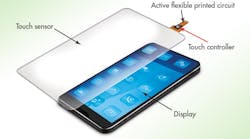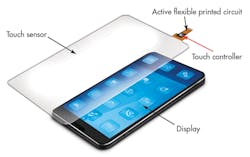What’s the Difference Between Resistive and Capacitive Touchscreens?
Smartphones and tablets have made touch-enabled interfaces an integral part of our lives, with touch rapidly becoming the user interface of choice across most applications and industries. A simple touch-based interface is no longer a key differentiating feature for high-end applications, though, and increasing competition between OEMs is driving down prices. Touchscreen systems represent one of the more expensive modules in portable applications, and they need to be designed in at a lower cost while still providing a high level of functionality.
Most touchscreens implement either resistive or projected-capacitance touch technology. Resistive touchscreens, which allow both finger and non-finger input (e.g., glove, stylus), are used in feature phones, global positioning systems (GPS), printers, digital cameras, and larger displays. They generally support single-finger touch and basic gestures, and cost less to produce.
On the other hand, projected-capacitance touchscreens, having superior multi-touch performance, durability, and optical clarity, are usually adopted into smartphones and tablets. However, projected-capacitance touchscsreens are now displacing resistive touch in most small- and medium-sized touchscreen devices, too. Moreover, increasing innovation in projected-capacitance touch, such as integrated stack-ups, has allowed it to be more price-competitive while surpassing resistive touch in performance.
Market Value
The primary value proposition of resistive touchscreens is that they are low cost to manufacture. Although resistive-touch performance is usually limited to basic single-finger touches and gestures, it still serves a wide user base. Resistive touchscreens can be found in automotive, medical, and industrial equipment, and of course, point-of-sale (POS) terminals.
Resistive touchscreens also continue to dominate applications that require touchscreens greater than 10 inches, since costs for projected-capacitance technologies rise exponentially with screen size. Furthermore, some original equipment manufacturers (OEMs) continue to employ resistive touchscreens in feature phones, GPS, digital still cameras, and printers with the aim to keep costs low in markets experiencing severe price competition.
In contrast, projected-capacitance touchscreens offer high performance in accuracy, power consumption, and refresh rate. They also feature excellent optical transmissivity (greater than 90%), resulting in brighter, clearer displays. Unlike resistive touchscreens, projected capacitance is durable, scratch-resistant, free of aging symptoms, and needs no calibration.
Projected capacitance can also support multi-finger touch input and gestures, enabling significant improvements to the user interface. Popular gestures such as two-finger pinch and zoom let users zoom in or out on an image. With multi-touch, OEMs are able to develop custom gestures, which add value for end users and can be promoted as product differentiators.
This file type includes high resolution graphics and schematics when applicable.
Touchscreen Composition
A major difference between resistive and projected-capacitance touch technology is touchscreen composition, which significantly impacts technical functionality and cost. The high-transparency and high-resistivity properties of indium-tin oxide (ITO) actually were first realized and taken advantage of by resistive touch technology.
Resistive touchscreens consist of two layers of polyethylene terephthalate (PET) with ITO coated on each layer (Fig. 1). The two layers of PET are separated by an air gap and spacer dots. The bottom PET layer is placed on top of an insulating substrate usually made of glass. A protective layer of hard coating is placed on top of the other PET layer. When a finger presses onto the touchscreen, the action causes the top and bottom ITO layers to physically come in contact, which signifies a finger touchdown. Resistive touchscreens come in 4-, 5-, 6-, and 8-wire variants, which offer different degrees of durability and noise suppression.
A standard capacitive touchscreen system (Fig. 2) comprises a projected-capacitive touchscreen sensor laminated to a protective cover lens, a bonded flexible printed circuit (FPC) with the touchscreen controller mounted to it, and a display. The FPC connects the touchscreen controller to the host processor. The display sits under the touchscreen sensor and is usually separated by an air gap or directly laminated.
Projected capacitance does not use pressure for touch detection—it can detect even the lightest of touches. The technology reads finger touches based on the differential change in capacitance when a finger is placed on the touchscreen.
Without pressure-based sensing, projected capacitance does away with bendable protective covers. Instead, thicker plastic or a glass cover lens that’s strong and scratch resistant can be deployed. Contrary to resistive touchscreens, projected-capacitance touchscreens is able to exploit glass or PET substrates, and they can be single or dual-layered. OEMs have multiple stack-up options for projected-capacitance touchscreens, too. Note that a single-layer sensor with ITO deposited on a glass substrate will greatly enhance the touchscreen’s optical clarity.
In addition, significant advances made by touchscreen controller suppliers like Cypress have led to projected-capacitance-supported passive styluses and gloves. Several years ago, such non-finger input support could only be provided by resistive touchscreens. Looking forward, further innovation in projected capacitance for novel features such as hover—detection of a finger hovering some distance above the touchscreen—opens up possibilities to even more revolutionary and enriching user experiences.
Drawbacks
Despite the widespread use of resistive touchscreens, there are considerable drawbacks, giving other touch technologies the chance to establish a presence and expand market share. Users consistently encounter frustration with resistive touchscreens that inaccurately report button activation on a different part of the touchscreen, or not activating presses as intended. Since resistive touchscreens depend on pressure-activated touch, this requires movement and flexing of the different layers in its stack-up. Moreover, the top hardcoat layer needs to be thin enough to maintain the flexibility of the touchscreen panel. The combination of moving layers and a thin protective layer leads to reduced durability and vulnerability to scratches.
Resistive touchscreens also suffer from lower optical transmissivity (< 80%). The construction of resistive touchscreens with two layers of PET, an air gap, and spacer dots can render a loss of refractive and reflective light, thereby yielding a more shaded display. Another negative attribute is that resistive touchscreens suffer from aging, which starts to occur when PET breaks down at high temperature. Signs of aging include touchscreen discoloration, where the touchscreen starts to turn white in color. Resistive touchscreens also have the disadvantage of requiring calibration. Calibration is needed to compensate for ITO-sheet resistance drift on PET.
Projected-capacitance technology does not have the shortcomings of resistive touchscreens, dislodging them in many high-end and high-volume applications. Because of the attractive properties of projected-capacitance touchscreens, an increasing number of consumers demand devices that use this technology. However, to support high-end devices as well as medium and lower-end devices, touch-panel and touch-controller suppliers must be innovative in cutting cost while still supporting full feature sets.
Reducing Cost
To achieve a more cost-efficient implementation, system designers working with capacitive technology must understand how component integration affects system cost and performance, both of which can be optimized with intelligent design choices.
Cover lens: The cover lens and touchscreen sensor are complex structures that constitute a touchscreen’s stack-up. The cover lens, the topmost layer, can be made of a variety of materials. Choosing a lens made with polymethyl methacrylate (PMMA) instead of glass can reduce cover-lens cost by up to 50%. PMMA is shatter-resistant but may lower signal sensitivity.
Touchscreen sensor: Figure 3 shows several touchscreen sensor stack-up options. Each layer has custom patterns and structures etched in either ITO on glass (better optical clarity) or a PET substrate (better noise immunity). Cost can be reduced by integrating layers. For example, a single-layer sensor can cost up to 50% less, making it attractive to applications that traditionally use resistive touchscreens or haven’t yet moved to a touchscreen-based interface.
Flexible printed circuit (FPC): The FPC interconnects the touchscreen panel, touchscreen controller, and host processor. More efficient FPC routing facilitates its integration with the rest of the system. Routing on a single layer also keeps cost to a minimum while increasing signal integrity.
Display: Displays couple noise to touchscreen sensors, diminishing sensitivity and increasing the potential for false touches. To mitigate noise, an additional ITO shielding layer can be placed between the display and touchscreen sensor. However, this adds cost and thickness to the module. Alternatively, an air gap of 0.2 to 0.5 mm can be used for separation. This helps reduce cost, but still requires the additional thickness.
Touchscreen controller: The touchscreen controller impacts performance, functionality, and the user experience by how well it handles processing of noise-sensitive signals. At a minimum, a controller needs high-quality analog front ends, built-in noise handling capabilities, and sophisticated processing algorithms. By providing a high signal-to-noise ratio (SNR) and effective noise handling, a controller can compensate for the signal-strength degradation that comes from noise sources, such as a cheaper cover lens or a noisy display. The controller also needs algorithms compatible with the sensors being used. To benefit from a single-layer FPC, the controller pin-out must support flexible routing. The controller also determines which advanced features, such as water tolerance or hover, the system can support.
Resistive touchscreens still reign in cost-sensitive applications that require large touchscreens. They also prevail in point-of-sale terminals, industrial, automotive, and medical applications. Overall, though, projected capacitance has become the dominant touchscreen technology in the market. It’s replaced resistive touchscreens in high-volume consumer electronics applications, such as mobile phones, tablets, GPS, digital still cameras, and MP3 players, by innovating to reduce solution costs as well as enhance features to make for more intuitive, yet exciting, user-interface options.
Understanding the capacitive touchscreen system and its key components gives developers a strong hand in significantly lower costs through different stack-up and component choices. In the end, it will bring capacitive technology to a wide range of mid- and low-end applications.
This file type includes high resolution graphics and schematics when applicable.




